Introduction
The fourth industrial revolution marked a period of technological development in the last half of the 18th century that has mainly changed the manufacturing, assembling, textile, and economic growth in the European and other Asian countries. Most commodities that were being crafted by hand initially have started to be produced in mass quantities by machines in factories, thanks to the introduction of machines and techniques in textiles, iron making, and other industries.
The idea of the fourth industrial revolution is based on the key characteristics, which include; the speed by which information is spread globally and the robust invention of technical and scientific discoveries in most parts of the world (Cotteleer and Sniderman, 2017). Therefore, the emergence of the fourth industrial revolution has led to an increase in productivity levels in the companies as the use of the new technology makes it easier to operate.
Contribution of 4th Industrial Revolution to the Globalization Process
The globalization process has increased with the introduction of the fourth industrial revolution in various countries which have benefited directly from the use of technology. Most industries have pursued various structural policies to ensure they use the technological advancement brought about by the fourth industrial revolution to increase their produce (Hagel et al., 2019). The fourth industrial policy is particularly needed when the economy experiences deep transformations, such as industrial revolutions.
The advent of digital globalization is primarily driven by the technological progress induced by the fourth industrial revolution. It is believed that industrial revolutions result from complex transformations of the economy, society, and culture. Globalization in the world was intended as the growth of world trade and foreign direct investments (Kreutzer et al., 2019). The acceleration of globalization started in the 1990s after the collapse of communism, leading to developing countries’ transition into new market economies.
Most firms currently sell in the international market through modern technologies, which has added their competitive edge and increased their production levels. Therefore, the firms have continued to interact with their customers regularly by creating new market forms and improving their product categories using the new technologies (Noor, 2019). In addition, there has been a recent growth in the global chain values as the firms use the technologies to ensure that they improve their logistics and operations and add value to their supply chain processes.
The fourth industrial revolution is composed of technology to improve the efficiency and effectiveness of service delivery and globalization. These technologies include; the uses of artificial intelligence, robotics, 3D printing, and digital platforms. Most companies have used these technologies to ensure that they provide high-quality and efficient products to their customers. The uses of these technologies have further been classified in the graph below;
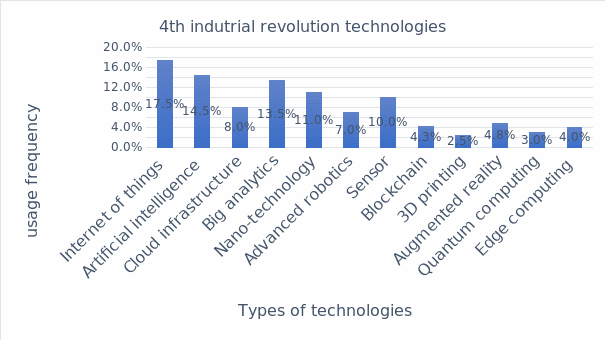
Connection of X and M with the 4th Industrial Revolution
Generally, the net amounts of exports and imports of various goods, services, intangible capital, and money have increased tremendously due to the technologies arising from the fourth industrial revolution. Most countries globally have experienced growth patterns in their economies due to the improvement in the incomes and the values from the net exports and imports from various sectors of their economy. In addition, the movement of people every year has increased gradually over the recent periods due to the industrial revolution, which has made it possible for individuals to travel from one place to another more easily.
Amount of X and M of Goods Per Year
Through the use of technologies related to the fourth industrial revolution, the exports and imports of goods in various countries have increased regularly. The fourth Industrial revolution policies are defined more broadly as actions to favor structural changes in industries and orient industrial development in specific directions. These actions include; trade, innovation, intellectual property rights, and antitrust, among others.
The net exports and imports in countries have increased rapidly over the years due to the contribution of the fourth industrial revolution. The statistics from the World Bank (2020) indicate that most countries performed higher after adopting the technologies derived from the fourth industrial revolution. The statistics are further presented below;
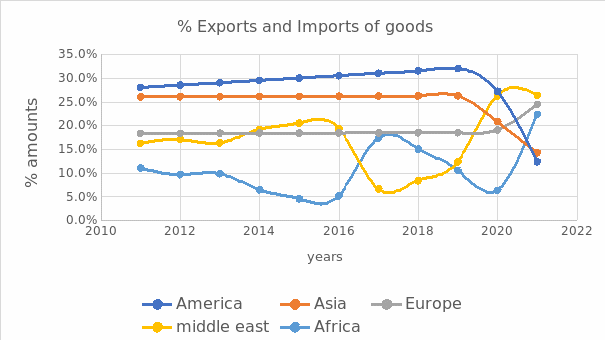
Amount of X and M of Services Per Year
In terms of the exports and imports of the services in the global market every year, China performs significantly higher than any other country, followed by the USA and other European countries such as the United Kingdom, Canada, and Germany. This statistic shows that there are many delivery services in China regarding the level of value addition. The recent reports from the global institutions have shown exponential growth in the global flow of data as most countries and continents do many data transfers leading to globalization.
The information on the volume of data exchanged from mobile phones, computers, and other communication devices implies that globalization has not slowed down, but rather it has taken a different form. The reports from United Nations Industrial Development Organization (2021) show statistics on global mobile data since 2011, with some forecasts over the period from 2016 to 2021. The result further indicates that mobile data traffic has grown from 2011 to 2016.
Global flows of mobile data are expected to exponentially increase in the future, from seven to 49 exabytes per month. From the regional perspective, the fastest growth is expected in Asia, accounting for almost half of the global data traffic by 2021. Hence even in terms of this indicator, Asia will consolidate its worldwide lead. In addition, the Middle East and Africa will experience robust growth in the next five years. The number of exports and imports of services per year is therefore demonstrated below;
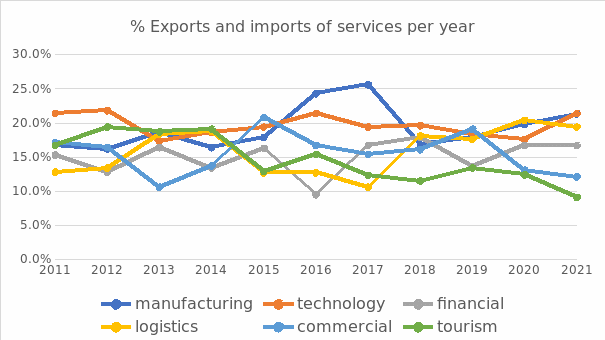
Amount of X and M of Intangible Capital Per Year
The newt value of exports and imports of the intangible capital per year from various countries is shown below. From the statistics, there has been rapid improvement in the amounts of intangible capital from various countries in the global market. This improvement has been facilitated mainly through the invention of trade and increased investment opportunities facilitated by the improved technological application in most parts of the global market (Ouvrard, 2018). The figure below therefore shows the performances of the intangible capital for the last 15 years in various countries;
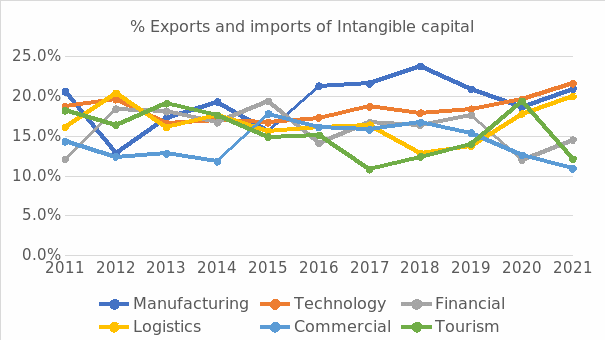
Amount of X and M of Money Per Year
The fourth industrial revolution has made most banking institutions record significant improvements in their financing activities geared explicitly towards industrial financing. Industrial growth demands capital availability from entrepreneurs and current business owners to fully realize it. Although the technology costs have declined due to the fourth industrial revolution, the financial sector’s overall demand for infrastructure funding has increased (Renjen, 2019). The net earnings from money per year have been generated from various sources such as; manufacturing, services, agricultural, and tourism industries. The number of exports and imports of money per year in the global market is therefore shown below;
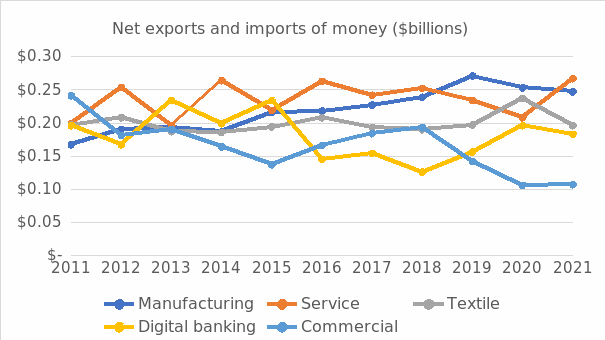
Amount of Movement of People Per Year
Due to the widespread internet usage, there has been a reduction in the technology costs facilitated through the fourth industrial revolution. Most individuals have been lucky to have access to digital networks as the world is becoming more global and more local at the same time. For instance, new industrial technologies such as 3D printing, new forms of factory automation, and machine learning have rapidly enabled mass personalization of products and local optimization of supply and demand (Schroeck, 2019). As a result of technological growth, the movement of people in the global market has expanded due to the value addition of the essential commodities consumed.
In addition, individuals connected to the internet have been brought together to operate as a typical village. Therefore, this integration has brought more opportunities due to the dynamics of human wants. As a result of increased technology usage and the need for access to the market, there has been an improvement in people’s movement per year in various countries. The graph below, therefore, shows the growth patterns in the movement of people from various parts of the world;
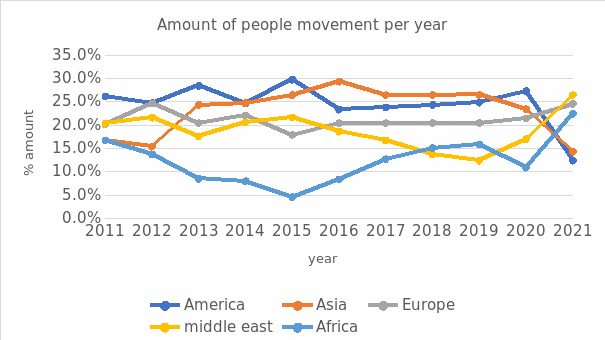
Countries benefiting from the 4th Industrial Revolution
The use of various technologies brought by the fourth industrial revolution has enabled most countries to adopt various strategies for ensuring their goods and services add value to the market. The most common countries benefiting from the fourth industrial revolution include; China, the USA, India, European countries, and other Asian countries such as Japan and South Korea (Susan & Burghin, 2019). China has benefited from the fourth industrial revolution due to its productivity level and various manufacturing, services, and technological sectors.
Therefore, the Chinese economy has improved gradually using the various technologies from the fourth industrial revolution. In addition, the USA economy has improved significantly due to the adoption of various techniques in their manufacturing and service delivery. The USA is considered among the strong world economies due to its ability to manage its resources effectively and produce local goods that have value-added to the global market (Wrigley, 2018). The US government has also been using the technology in the military and other financial industries.
The Indian economy is considered one of the largest digital adopters in the entire global market. Digital transformation is essential to the Indian economy as they require new skills and constant redeployment in their factories. Therefore, the Indian economy has to continue investing and ensuring that the manufacturing skills do not get lost by reskilling its labor market using the technology from the fourth industrial revolution.
The Arabian and Asian countries such as Saudi Arabia, Japan, South Korea, and Bangladesh have benefited mainly from the fourth industrial revolution due to their ability to manufacture goods in large volumes. They have also ventured into the agricultural products made effective using modern technologies (United Nations Industrial Development Organization, 2017). The services and assembling industries in these Arabian and Asian countries have improved due to the technologies adopted in production.
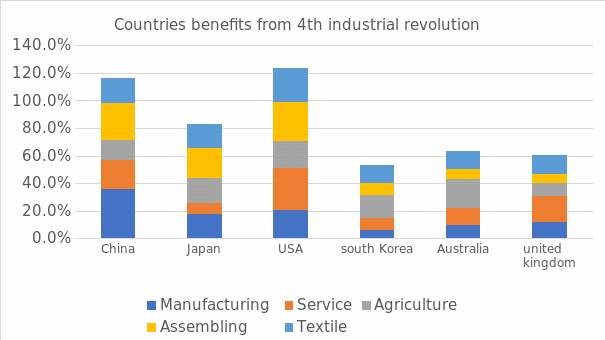
Conclusion
In conclusion, the fourth industrial revolution has made it possible for countries and manufacturing companies to produce and stabilize their economies. Countries that have adopted the technologies from the fourth industrial revolution have witnessed rapid economic growth due to the various benefits originating from technological advancement. Due to the Industrial Revolution, there have been improved net exports and imports of services, goods, and capital movement in the global market. The financial sectors, assembling, agricultural, and manufacturing sectors have also improved due to the benefits of the industrial revolution in the 21st century.
Reference List
Cotteleer, M. and Sniderman, B.(2017). Forces of change: Industry 4.0. Deloitte Insights.
Hagel, J., Brown, J., and Wooll, M. (2019). Skills change, but capabilities endure. Deloitte Insights.
Kreutzer, S., Sedeski, F. and Merki, F.(2019). Case study of Nigeria. Unlocking the potential of the fourth industrial revolution in Africa. African Development Bank Group. Study Report.
Noor, R.(2019). Industry 4.0: Industrial Revolution in the heart of SDG agenda 2030. MIT Climate.
Ouvrard, C. (2018). Industry 4.0 could be a key player in mitigating climate change. Construction International.
Renjen, P.(2019). How leaders are navigating the fourth industrial revolution. Deloitte Review 24.
Schroeck, M. (2019). Digital industrial transformation: Reinventing to win in Industry 4.0. Deloitte Insights.
Susan, L. and Burghin, J. (2019). Next-generation technologies and the future of trade. VOX CEPR Policy Portal.
United Nations Industrial Development Organization,(2021). Accelerating clean energy through Industry 4.0, International Research Journal.
World Bank, (2020). World development indicators, Journal of Economic Research.
Wrigley, K. (2018). Reconsidering the industrial revolution: England and Wales. Journal of Interdisciplinary History, pp. 49(1): 9-42.